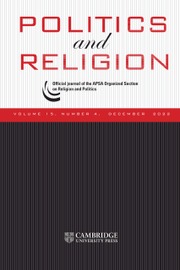Crossref Citations
This article has been cited by the following publications. This list is generated based on data provided by
Crossref.
Koenig, Harold G.
and
Shohaib, Saad Al
2014.
Health and Well-Being in Islamic Societies.
p.
217.
Corstange, Daniel
2014.
Anti-American Behavior in the Middle East.
SSRN Electronic Journal,
Benstead, Lindsay J.
2014.
Does Interviewer Religious Dress Affect Survey Responses? Evidence from Morocco.
Politics and Religion,
Vol. 7,
Issue. 4,
p.
734.
Dionne, Kim Yi
2014.
The politics of local research production: surveying in a context of ethnic competition.
Politics, Groups, and Identities,
Vol. 2,
Issue. 3,
p.
459.
Jiang, Junyan
and
Yang, Dali L.
2015.
Lying or Believing? Measuring Preference Falsification from a Political Purge in China.
SSRN Electronic Journal,
Benstead, Lindsay J.
Jamal, Amaney A.
and
Lust, Ellen
2015.
Is It Gender, Religiosity or Both? A Role Congruity Theory of Candidate Electability in Transitional Tunisia.
Perspectives on Politics,
Vol. 13,
Issue. 1,
p.
74.
Christia, Fotini
2016.
To Karbala: Surveying Religious Shi'a from Iran and Iraq.
SSRN Electronic Journal,
Himelein, Kristen
2016.
Interviewer Effects in Subjective Survey Questions: Evidence From Timor-Leste.
International Journal of Public Opinion Research,
Vol. 28,
Issue. 4,
p.
511.
Jiang, Junyan
and
Yang, Dali L.
2016.
Lying or Believing? Measuring Preference Falsification From a Political Purge in China.
Comparative Political Studies,
Vol. 49,
Issue. 5,
p.
600.
Dzutsati, Valery
Siroky, David
and
Dzutsev, Khasan
2016.
The Political Economy of Support for Sharia: Evidence from the Russian North Caucasus.
Politics and Religion,
Vol. 9,
Issue. 4,
p.
695.
Adida, Claire L.
Ferree, Karen E.
Posner, Daniel N.
and
Robinson, Amanda Lea
2016.
Who’s Asking? Interviewer Coethnicity Effects in African Survey Data.
Comparative Political Studies,
Vol. 49,
Issue. 12,
p.
1630.
Masoud, Tarek
Jamal, Amaney
and
Nugent, Elizabeth
2016.
Using the Qur’ān to Empower Arab Women? Theory and Experimental Evidence From Egypt.
Comparative Political Studies,
Vol. 49,
Issue. 12,
p.
1555.
Shahin, Magda
and
El‐Ghazaly, Yasmeen
2017.
The Impact of Notions of Nationalism on Women's Rights in Egypt.
Studies in Ethnicity and Nationalism,
Vol. 17,
Issue. 2,
p.
177.
Butler, Daniel M.
and
Tavits, Margit
2017.
Does the Hijab Increase Representatives’ Perceptions of Social Distance?.
The Journal of Politics,
Vol. 79,
Issue. 2,
p.
727.
Lazarev, Egor
and
Sharma, Kunaal
2017.
Brother or Burden: An Experiment on Reducing Prejudice Toward Syrian Refugees in Turkey.
Political Science Research and Methods,
Vol. 5,
Issue. 2,
p.
201.
Mostafa, Diana
Ehab, K. A. Mohamed
and
Hussain, Mostaq M.
2017.
The Effect of Religiosity & Morality Interaction on the Degree of Auditor Independence: The Case of Egypt.
SSRN Electronic Journal ,
Brooke, Steven
2017.
From Medicine to Mobilization: Social Service Provision and the Islamist Reputational Advantage.
Perspectives on Politics,
Vol. 15,
Issue. 1,
p.
42.
Morosanu, Alina
Jaba, Elisabeta
and
Serban, Daniela
2017.
The Proposal of a Tool for Candidates Selection for Employment. The Case of Survey Interviewers.
Prague Economic Papers,
Vol. 26,
Issue. 5,
p.
561.
Yang, Xiaozhao Yousef
and
Yang, Fenggang
2017.
Estimating Religious Populations with the Network Scale‐Up Method: A Practical Alternative to Self‐Report.
Journal for the Scientific Study of Religion,
Vol. 56,
Issue. 4,
p.
703.
Nugent, Elizabeth
2017.
The Psychology of Repression and Polarization in Authoritarian Regimes.
SSRN Electronic Journal,

